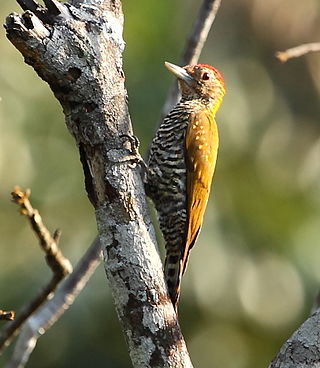Related Research Articles

Ernst Walter Mayr was one of the 20th century's leading evolutionary biologists. He was also a renowned taxonomist, tropical explorer, ornithologist, philosopher of biology, and historian of science. His work contributed to the conceptual revolution that led to the modern evolutionary synthesis of Mendelian genetics, systematics, and Darwinian evolution, and to the development of the biological species concept.

Ornithology is a branch of zoology that concerns the "methodological study and consequent knowledge of birds with all that relates to them." Several aspects of ornithology differ from related disciplines, due partly to the high visibility and the aesthetic appeal of birds. It has also been an area with a large contribution made by amateurs in terms of time, resources, and financial support. Studies on birds have helped develop key concepts in biology including evolution, behaviour and ecology such as the definition of species, the process of speciation, instinct, learning, ecological niches, guilds, island biogeography, phylogeography, and conservation.

The Accipitriformes are an order of birds that includes most of the diurnal birds of prey, including hawks, eagles, vultures, and kites, but not falcons.

The Pelecaniformes are an order of medium-sized and large waterbirds found worldwide. As traditionally—but erroneously—defined, they encompass all birds that have feet with all four toes webbed. Hence, they were formerly also known by such names as totipalmates or steganopodes. Most have a bare throat patch, and the nostrils have evolved into dysfunctional slits, forcing them to breathe through their mouths. They also have a pectinate nail on their longest toe. This is shaped like a comb and is used to brush out and separate their feathers. They feed on fish, squid, or similar marine life. Nesting is colonial, but individual birds are monogamous. The young are altricial, hatching from the egg helpless and naked in most. They lack a brood patch.

The Old World flycatchers are a large family, the Muscicapidae, of small passerine birds restricted to the Old World, with the exception of several vagrants and two species, bluethroat and northern wheatear, found also in North America. These are mainly small arboreal insectivores, many of which, as the name implies, take their prey on the wing. The family includes 352 species and is divided into 51 genera.

The green-cheeked parakeet, known as the green-cheeked conure in aviculture, is a species of bird in subfamily Arinae of the family Psittacidae, the African and New World parrots. It is found in Argentina, Bolivia, Brazil, and Paraguay.
The Cornell Lab of Ornithology is a member-supported unit of Cornell University in Ithaca, New York, which studies birds and other wildlife. It is housed in the Imogene Powers Johnson Center for Birds and Biodiversity in Sapsucker Woods Sanctuary. Approximately 250 scientists, professors, staff, and students work in a variety of programs devoted to the Lab's mission: interpreting and conserving the Earth's biological diversity through research, education, and citizen science focused on birds. Work at the Lab is supported primarily by its 75,000 members.

The yellow-throated sparrow or chestnut-shouldered petronia is a species of sparrow found in southern Asia.

The white-bellied parrot, or white-bellied caique in aviculture, is a species of bird in subfamily Arinae of the family Psittacidae, the African and New World parrots. It is found in Bolivia, Brazil, Colombia, and Peru.

The black-headed parrot is a species of bird in subfamily Arinae of the family Psittacidae, the African and New World parrots. Other colloquial names are black-crowned parrot, black-capped parrot, black-headed caique, and for subspecies P. m. pallidus, pallid caique. It is found in Brazil, Colombia, Ecuador, French Guiana, Guyana, Peru, Suriname, and Venezuela.

The white-breasted parakeet or white-necked parakeet is a Vulnerable species of bird in subfamily Arinae of the family Psittacidae, the African and New World parrots. It is found in southern Ecuador and possibly in adjacent northern Peru.

The blaze-winged parakeet, known as the blaze-winged conure in aviculture, is a species of bird in subfamily Arinae of the family Psittacidae, the African and New World parrots. It is found in Brazil, Paraguay, and possibly Argentina.

The pearly parakeet, known as the pearly conure in aviculture, is a Vulnerable species in subfamily Arinae of the family Psittacidae, the African and New World parrots. It is endemic to Brazil.
Storrs Lovejoy Olson was an American biologist and ornithologist who spent his career at the Smithsonian Institution, retiring in 2008. One of the world's foremost avian paleontologists, he was best known for his studies of fossil and subfossil birds on islands such as Ascension, St. Helena and Hawaii. His early higher education took place at Florida State University in 1966, where he obtained a B.A. in biology, and the University of Florida, where he received an M.S. in biology. Olson's doctoral studies took place at Johns Hopkins University, in what was then the School of Hygiene and Public Health. He was married to fellow paleornithologist Helen F. James.

The golden-collared woodpecker is a species of bird in subfamily Picinae of the woodpecker family Picidae. It is found in Brazil, the Guianas, and Venezuela.

The yellow-eared woodpecker is a species of bird in subfamily Picinae of the woodpecker family Picidae. It is endemic to eastern Brazil.
David William Steadman is a paleontologist and ornithologist, and serves as the curator of ornithology at the Florida Museum of Natural History at the University of Florida.
The order Falconiformes is represented by the extant family Falconidae and a handful of enigmatic Paleogene species. Traditionally, the other bird of prey families Cathartidae, Sagittariidae (secretarybird), Pandionidae (ospreys), Accipitridae (hawks) were classified in Falconiformes. A variety of comparative genome analysis published since 2008, however, found that falcons are part of a clade of birds called Australaves, which also includes seriemas, parrots and passerines. Within Australaves falcons are more closely related to the parrot-passerine clade (Psittacopasserae), which together they form the clade Eufalconimorphae. The hawks and vultures occupy a basal branch in the clade Afroaves in their own clade Accipitrimorphae, closer to owls and woodpeckers.
Dioscoro Siarot Rabor, also known as Joe Rabor, was a Filipino ornithologist, zoologist, and conservationist. Known as the "Father of Philippine Wildlife Conservation", he led more than 50 wildlife expeditions in the Philippines, authored 87 scientific papers and articles, and described 69 new bird taxa and numerous mammal species.

Strisores, sometimes called nightbirds, is a clade of birds that includes the living families and orders Caprimulgidae, Nyctibiidae (potoos), Steatornithidae (oilbirds), Podargidae (frogmouths), Apodiformes, as well as the Aegotheliformes (owlet-nightjars) whose distinctness was only recently realized. The Apodiformes and the Aegotheliformes form the Daedalornithes.
References
- ↑ "Sushma Reddy". Department of Fisheries, Wildlife and Conservation Biology. Retrieved 13 March 2023.
- ↑ Zampogna, Gretchen (9 July 2018). "Welcome Dr. Sushma Reddy". Bell Museum. Retrieved 13 March 2023.
- ↑ Smith, Daniel P. "Biology Professor Sushma Reddy discovers new bird species". Loyola University Chicago. Retrieved 13 March 2023.
- ↑ Scott, Graham (24 September 2020). Essential Ornithology. Oxford University Press. p. 9. ISBN 978-0-19-252695-3.
- ↑ Publications: Générale. International Union of Biological Sciences. 2000. p. 46. ISBN 978-92-9046-083-1.